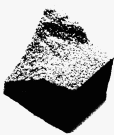 A piece of desert floral foam, cracked by twisting (Mode 3).
A piece of desert floral foam, cracked by twisting (Mode 3).
I was talking with my friend Wash Wawrzynek about his 3-D simulations of cracks; his group (Tony Ingraffea's group in civil engineering) cracks everything from shuttle doors to turbine blades on the computer. It became clear that, while the laws for computing the stress at the crack tip were known, the laws governing the resulting growth of the crack were not: Wash had implemented sensible choices but had no context to decide what a growth law should look like. I asked Jennifer Hodgdon to look into what the most general growth law allowed by symmetry should look like. She showed that the known laws of crack growth in two dimensions followed from her formalism, and then (making use of several discrete symmetries, a gauge symmetry following from re-parameterization invariance, dimensional analysis, and a few enlightening experiments with cheese, cake, and desert floral foam) found a relatively simple general form for the evolution of curved, mixed-mode crack growth in three dimensions. Jay Maynard and Cindy Krysac started their crack growth experiments with desert floral forms, but ended up with carbon foams...
![]() James P. Sethna, sethna@lassp.cornell.edu
James P. Sethna, sethna@lassp.cornell.edu
![]() Statistical Mechanics: Entropy, Order Parameters, and Complexity,
now available at
Oxford University Press
(USA,
Europe).
Statistical Mechanics: Entropy, Order Parameters, and Complexity,
now available at
Oxford University Press
(USA,
Europe).